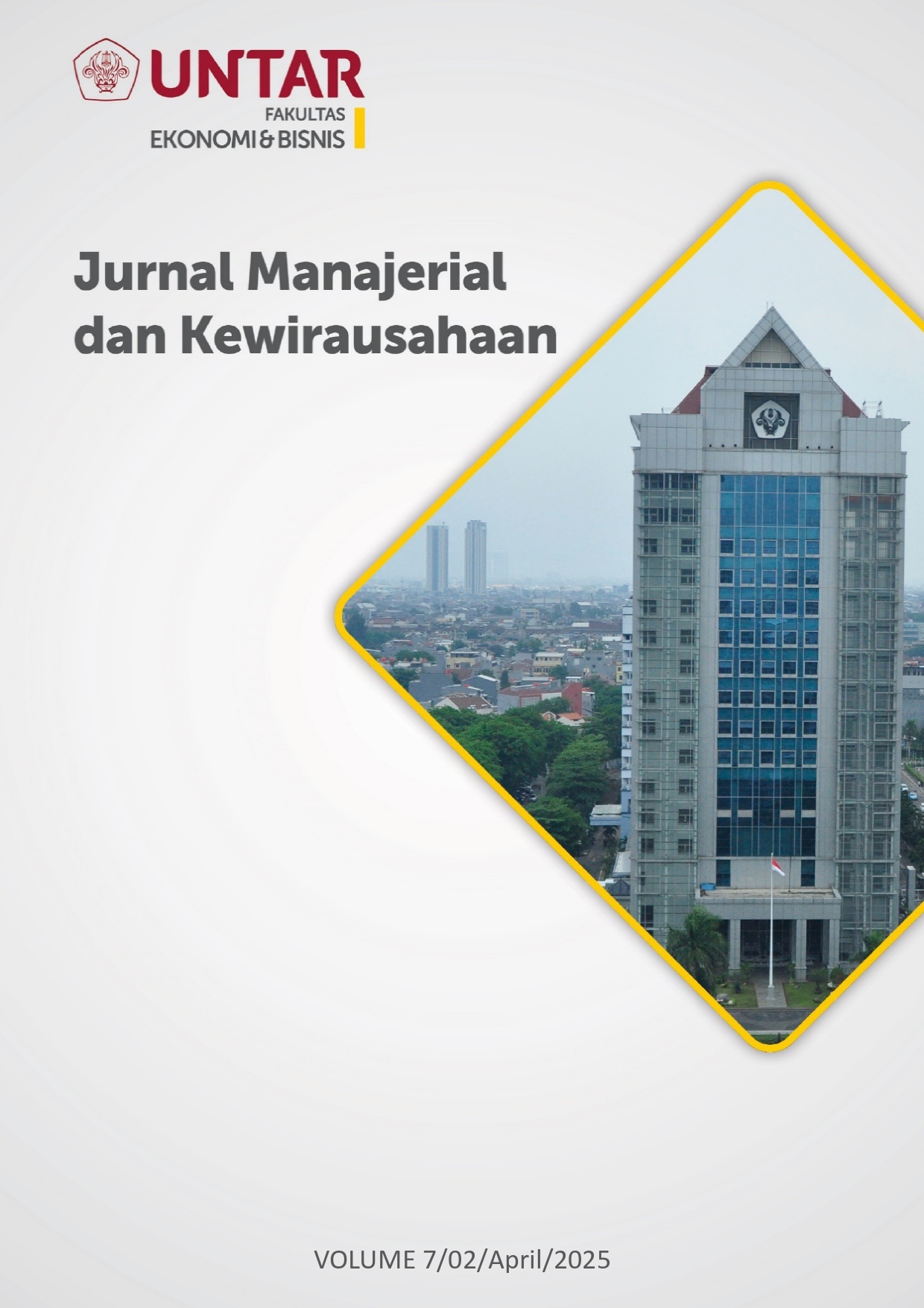Social Comparison, FOMO, dan Materialism sebagai Mediator Imitation of Influencers terhadap Purchase Intention Generasi Muda
Main Article Content
Abstract
This study aims to analyze the effect of imitating influencers on the purchase intention of Corkcicle products with the mediating role of social comparison, fear of missing out (FOMO), and materialism in the Millennial generation and Gen Z in Indonesia. The sampling technique used was non-probability sampling with a purposive sampling technique. This study uses a quantitative approach with an online survey method through Google Forms, involving 210 respondents who are active on social media and familiar with Corkcicle products. Data analysis was conducted using Structural Equation Modeling-Partial Least Squares (SEM-PLS) and data processing using SmartPLS. Results indicate that imitation of influencers has a significant influence on social comparison and materialism and that social comparison mediates the relationship between imitation of influencers with FOMO and materialism. Furthermore, FOMO and materialism mediate the link between social comparison and purchase intention. These findings offer new insights into the influence of imitating influencers on purchase intention, which can be utilized by Corkcicle to plan a strategy for more effective influencer-based marketing.
Article Details

This work is licensed under a Creative Commons Attribution-NonCommercial-ShareAlike 4.0 International License.
This work is licensed under a Jurnal Muara Ilmu Ekonomi dan Bisnis Creative Commons Attribution-ShareAlike 4.0 International License.,/p>
References
Abidin, C. (2016). Visibility labour: Engaging with Influencers’ fashion brands and #OOTD advertorial campaigns on Instagram. Media International Australia, 161(1), 86–100. https://doi.org/10.1177/1329878X16665177
Asia, C. (2023). The Power of Influence E-commerce Influencer Marketing in Southeast Asia. https://go.impact.com/rs/280-XQP-994/images/RRT-INFL-ED-eCommerce-Influencer-Marketing-SEA.pdf
Bandura, A. (1977). Social Learning Theory. General Learning Press. https://doi.org/10.18177/sym.2020.61.1.sr.11518
Chan, K., & Prendergast, G. P. (2008). Social comparison, imitation of celebrity models and materialism among Chinese youth. International Journal of Advertising, 27(5), 799–826. https://doi.org/10.2501/S026504870808030X
Christen, M., & Morgan, R. M. (2005). Keeping up with the Joneses: Analyzing the effect of income inequality on consumer borrowing. Quantitative Marketing and Economics, 3(2), 145–173. https://doi.org/10.1007/s11129-005-0351-1
Cintalia, M., & Yenita, Y. (2023). Peran customer reviews dan imitation of influencers terhadap purchase intention yang dimoderasi trust pada luxury restaurant di Jakarta. Jurnal Manajemen Bisnis dan Kewirausahaan, 7(6), 1328-1338. https://doi.org/10.24912/jmbk.v7i6.27265
De Veirman, M., Cauberghe, V., & Hudders, L. (2017). Marketing through instagram influencers: The impact of number of followers and product divergence on brand attitude. International Journal of Advertising, 36(5), 798–828. https://doi.org/10.1080/02650487.2017.1348035
Deci, E. L., & Ryan, R. M. (1985). Intrinsic Motivation and Self-Determination in Human Behavior (1st ed.). Springer US. https://doi.org/10.1007/978-1-4899-2271-7
Dittmar, H. (2011). Handbook of Identity Theory and Research. In S. J. Schwartz, K. Luyckx, & V. L. Vignoles (Eds.), Handbook of Identity Theory and Research. Springer New York. https://doi.org/10.1007/978-1-4419-7988-9
Domagalski, T. A., & Kasser, T. (2004). The High Price of Materialism. The Academy of Management Review, 29(1), 135. https://doi.org/10.2307/20159018
Ferle, C. La, & Chan, K. (2008). Determinants for materialism among adolescents in Singapore. Young Consumers, 9(3), 201–214. https://doi.org/10.1108/17473610810901633
Geraldi, L., & Tunjungsari, H. K. (2023). Pengaruh kredibilitas dan citra influencer pada konsumen Scarlett purchase intention. Jurnal Manajerial dan Kewirausahaan, 5(4), 1043–1050. https://doi.org/10.24912/jmk.v5i4.26979
Good, M. C., & Hyman, M. R. (2021). Direct and indirect effects of fear-of-missing-out appeals on purchase likelihood. Journal of Consumer Behaviour, 20(3), 564–576. https://doi.org/10.1002/cb.1885
Hair, J. F., Black, W. C., Babin, B. J., & Anderson, R. E. (2014). Multivariate Data Analysis.pdf. In Australia : Cengage: Vol. 7 edition.
Hair, J. F., Hult, G. T., Ringle, C., & Sarstedt, M. (2017). A Primer on Partial Least Squares Structural Equation Modeling (PLS-SEM). Sage.
Liu, M. T., & Brock, J. L. (2011). Selecting a female athlete endorser in China: The effect of attractiveness, match-up, and consumer gender difference. European Journal of Marketing, 45(7), 1214–1235. https://doi.org/10.1108/03090561111137688
Malhotra, N. K. (2010). Marketing Research: An Applied Orientation. Pearson Education. https://books.google.co.id/books?id=VLwVPwAACAAJ
Przybylski, A. K., Murayama, K., Dehaan, C. R., & Gladwell, V. (2013). Motivational, emotional, and behavioral correlates of fear of missing out. Computers in Human Behavior, 29(4), 1841–1848. https://doi.org/10.1016/j.chb.2013.02.014
Richins, M. L. (2004). The material values scale: Measurement properties and development of a short form. Journal of Consumer Research, 31(1), 209–219. https://doi.org/10.1086/383436
Richins, M. L., & Dawson, S. (1992). A Consumer Values Orientation for Materialism and Its Measurement: Scale Development and Validation. Journal of Consumer Research, 19(3), 303. https://doi.org/10.1086/209304
Sekaran, U., & Bougie, R. (2013). Research Methods for Business: A Skill-Building Approach. In Leadership & Organization Development Journal (Vol. 34, Issue 7). https://doi.org/10.1108/lodj-06-2013-0079
Shen, Z. (2021). A persuasive eWOM model for increasing consumer engagement on social media: evidence from Irish fashion micro-influencers. Journal of Research in Interactive Marketing, 15(2), 181–199. https://doi.org/10.1108/JRIM-10-2019-0161
Sirgy, M. J. (1998). Migraine and quality of life. Neurologia, 43(3), 227–260.
Solberg, E. C., Diener, E., Wirtz, D., Lucas, R. E., & Oishi, S. (2002). Wanting, having, and satisfaction: Examining the role of desire discrepancies in satisfaction with income. Journal of Personality and Social Psychology, 83(3), 725–734. https://doi.org/10.1037/0022-3514.83.3.725
Sung, Y., & Choi, S. M. (2012). The influence of self-construal on self-brand congruity in the United States and Korea. Journal of Cross-Cultural Psychology, 43(1), 151–166. https://doi.org/10.1177/0022022110383318
Tsang, J. A., Carpenter, T. P., Roberts, J. A., Frisch, M. B., & Carlisle, R. D. (2014). Why are materialists less happy? The role of gratitude and need satisfaction in the relationship between materialism and life satisfaction. Personality and Individual Differences, 64(July), 62–66. https://doi.org/10.1016/j.paid.2014.02.009
Water Bottle Market Size, Trends & Industry Forecast. (2024). Fortune Business Insights. https://www.fortunebusinessinsights.com/water-bottle-market-104635



